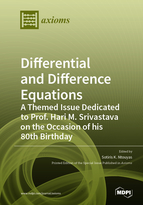Differential and Difference Equations: A Themed Issue Dedicated to Prof. Hari M. Srivastava on the Occasion of his 80th Birthday
A special issue of Axioms (ISSN 2075-1680). This special issue belongs to the section "Mathematical Analysis".
Deadline for manuscript submissions: closed (31 May 2020) | Viewed by 56673
Special Issue Editor
Interests: initial value problems; boundary value problems; inequalities
Special Issues, Collections and Topics in MDPI journals
Special Issue Information
Dear Colleagues,
This Special Issue of Axioms is dedicated to Professor Hari Mohan Srivastava on the occasion of his 80th Birthday, as recognition of his significant contribution in the field.
Hari Mohan Srivastava was born on 05 July 1940 in Karon (District Ballia) in the Province of Uttar Pradesh in India. Professor Hari Mohan Srivastava began his university-level teaching career right after having received his M.Sc. degree in 1959 at the age of 19 years. He earned his Ph.D. degree in 1965 while he was a full-time member of the teaching faculty at the Jai Narain Vyas University of Jodhpur in India (since 1963). Currently, Professor Srivastava holds the position of Professor Emeritus in the Department of Mathematics and Statistics at the University of Victoria in Canada, having joined the faculty there in 1969. Professor Srivastava has held (and continues to hold) numerous Visiting and Chair Professorships at many universities and research institutes in many different parts of the world. Having received several D.Sc. (honoris causa) degrees as well as honorary memberships and fellowships of many scientific academies and scientific societies around the world, he is also actively associated editorially with numerous international scientific research journals as an Honorary or Advisory Editor or as an Editorial Board Member. He has also edited (and is currently editing) many Special Issues of scientific research journals as the Lead Guest Editor, including (for example) the MDPI journals Axioms, Mathematics, and Symmetry, the Elsevier journals Journal of Computational and Applied Mathematics and Applied Mathematics and Computation, the Wiley journal Mathematical Methods in the Applied Sciences, and so on. He is a Clarivate Analytics [Thomson Reuters] (Web of Science) Highly-Cited Researcher.
Professor Srivastava’s research interests include several areas of pure and applied mathematical sciences, such as (for example) real and complex analysis, fractional calculus and its applications, integral equations and transforms, higher transcendental functions and their applications, q-series and q-polynomials, analytic number theory, analytic and geometric inequalities, probability and statistics, and inventory modeling and optimization. He has published 33 books, monographs, and edited volumes, 33 book (and encyclopedia) chapters, 48 papers in international conference proceedings, and more than 1200 peer-reviewed international scientific research journal articles, as well as Forewords and Prefaces to many books and journals.
Further details about Professor Srivastava’s professional achievements and scholarly accomplishments, as well as honors, awards and distinctions, can be found at the following website:
http://www.math.uvic.ca/~harimsri/
Differential and difference equations play an important role in many branches of mathematics. This Special Issue deals with the theory and applications of differential and difference equations. We invite high-quality original research papers, as well as survey papers related to the topic of this issue.
We look forward to your contributions.
Best wishes,
Prof. Dr. Sotiris K. Ntouyas
Guest Editor
Manuscript Submission Information
Manuscripts should be submitted online at www.mdpi.com by registering and logging in to this website. Once you are registered, click here to go to the submission form. Manuscripts can be submitted until the deadline. All submissions that pass pre-check are peer-reviewed. Accepted papers will be published continuously in the journal (as soon as accepted) and will be listed together on the special issue website. Research articles, review articles as well as short communications are invited. For planned papers, a title and short abstract (about 100 words) can be sent to the Editorial Office for announcement on this website.
Submitted manuscripts should not have been published previously, nor be under consideration for publication elsewhere (except conference proceedings papers). All manuscripts are thoroughly refereed through a single-blind peer-review process. A guide for authors and other relevant information for submission of manuscripts is available on the Instructions for Authors page. Axioms is an international peer-reviewed open access monthly journal published by MDPI.
Please visit the Instructions for Authors page before submitting a manuscript. The Article Processing Charge (APC) for publication in this open access journal is 2400 CHF (Swiss Francs). Submitted papers should be well formatted and use good English. Authors may use MDPI's English editing service prior to publication or during author revisions.
Keywords
- ordinary differential equations
- difference equations
- partial differential equations
- fractional differential equations
- stochastic differential equations
- time scale dynamic equations
- related topics about the differential equations





